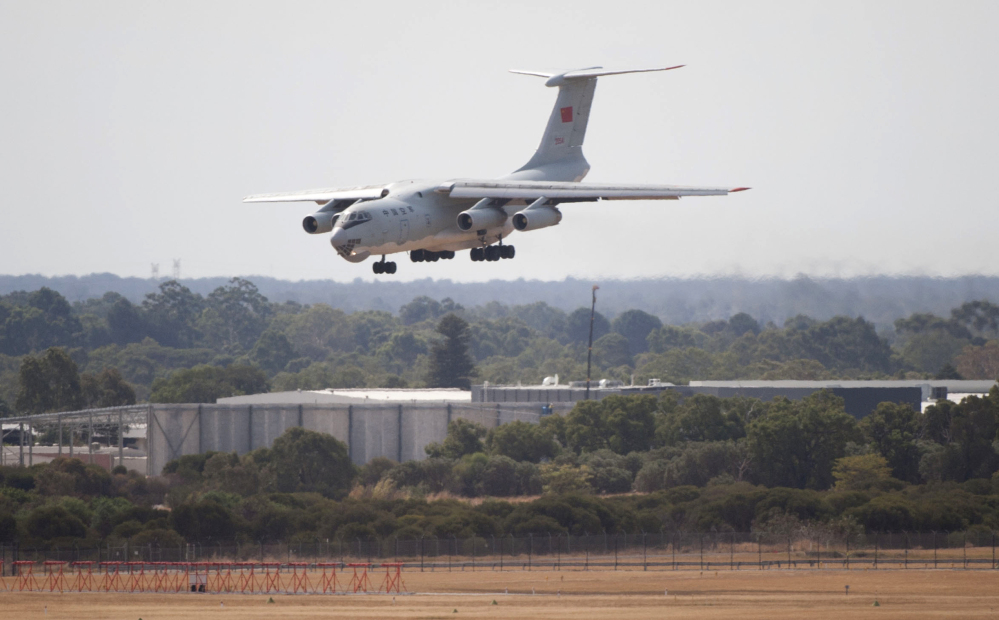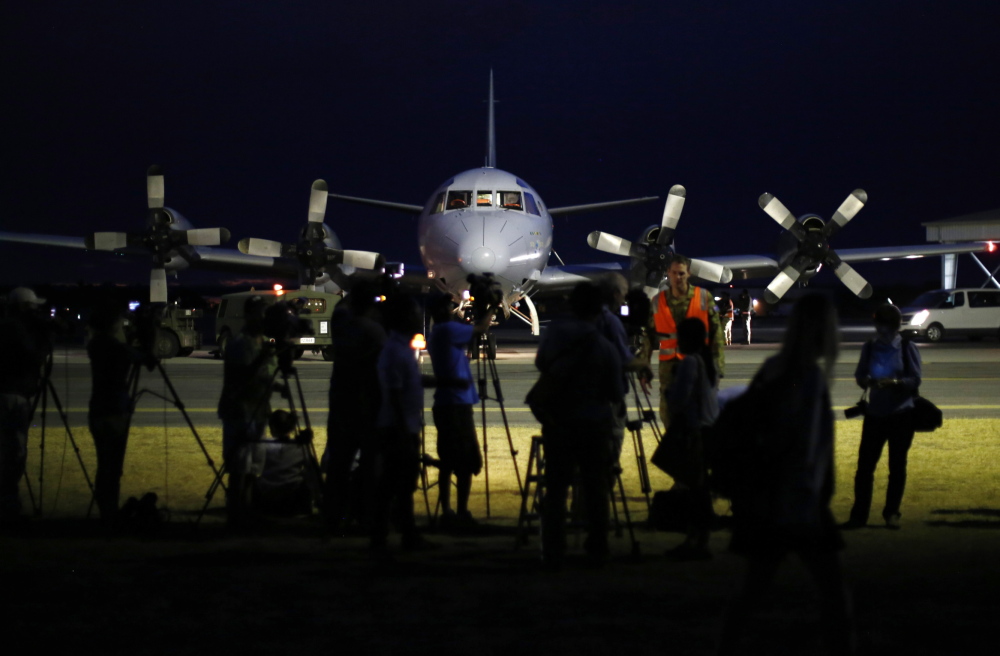KUALA LUMPUR, Malaysia — After 17 days of desperation and doubt over the missing Malaysia Airlines jet, the country’s officials said an analysis of satellite data points to a “heartbreaking” conclusion: Flight 370 met its end in the southern reaches of the Indian Ocean, and none of those aboard survived.
The somber announcement late Monday by Prime Minister Najib Razak left unresolved many more troubling questions about what went wrong aboard the Boeing 777 to take it so far off-course.
It also unleashed a maelstrom of sorrow and anger among the families of the jet’s 239 passengers and crew.
A solemn Najib, clad in a black suit, read a brief statement about what he called an unparalleled study of the jet’s last-known signals to a satellite. That analysis showed that the missing plane, which took off from Kuala Lumpur for Beijing early on March 8, veered “to a remote location, far from any possible landing sites.”
“It is therefore with deep sadness and regret that I must inform you that, according to this new data, Flight MH370 ended in the southern Indian Ocean,” he said.
His carefully chosen words did not directly address the fate of those aboard. But in a separate message, sent to some of their relatives just before he spoke, Malaysia Airlines officials said that “we have to assume beyond any reasonable doubt that MH370 has been lost and that none of those on board survived.”
Officials said they concluded that the flight had been lost in the deep waters west of Perth, Australia, based on more thorough analysis of the brief signals the plane sent every hour to a satellite belonging to Inmarsat, a British company, even after other communication systems on the jetliner shut down.
The pings did not include any location information. But Inmarsat and British aviation officials used “a type of analysis never before used in an investigation of this sort” to zero in on the plane’s last direction, as it reached the end of its fuel, Najib said.
In a statement, Inmarsat said the company used “detailed analysis and modelling” of transmissions from the Malaysia Airlines jet and other known flights to describe “the likely direction of flight of MH370.”
Najib gave no indication of exactly where in the Indian Ocean the plane was last heard from, but searchers have sighted possible debris in an area about 1,550 miles southwest of Perth.
High waves, gale-force winds and low-hanging clouds forced the multinational search to be suspended for 24 hours Tuesday, the Australian Maritime Safety Authority said in a statement.
Australian Transport Minister Warren Truss, who is responsible for the search coordination, said Tuesday in Canberra the determination that the plane had crashed shifts the search to a new phase, but that it would be a difficult and long one.
“The Malaysian announcement is purely based on the satellite imagery that’s available, the calculations about fuel and capacity of the aircraft to stay in the air, so it’s really a long, long way away before much can be done by way of physical examination,” he said.
He said that under international agreements governing air travel, “Malaysia needs to take control” and decide how to proceed.
Truss said the Australian naval supply ship HMAS Success had been in the area where objects had been spotted Monday, but its crew had been unable to find anything. He said he did not expect the search for debris would be scaled back in the short term.
“Obviously, recovery of any kind of debris that may be related to the aircraft will be important for the investigative stage,” he said. “So it’s still important for us to try and find as much of the aircraft as possible.”
There is also a race against the clock to find any trace of the plane that could lead them to the location of the black boxes, the common name for the cockpit voice and data recorders, whose battery-powered “pinger” could stop sending signals within two weeks. The batteries are designed to last at least a month and can last longer. The plane disappeared March 8.
Some of the relatives who gathered to listen to Najib met the news with shrieks and uncontrolled sobs. Others collapsed into the arms of loved ones.
“My son! My son!” cried a woman in a group of about 50 gathered at a hotel near Beijing’s airport, before falling to her knees. Minutes later, medical teams carried one elderly man out of the conference room on a stretcher, his face covered by a jacket.
In Kuala Lumpur, screams came from inside the Hotel Bangi Putrajaya, where some of the families have been given rooms.
Selamat Omar, father of a 29-year-old aviation engineer aboard the flight, said in a telephone interview that he and other families were waiting for word about whether they would be flown to Australia, closer to where it is believed the plane went down.
“We accept the news of the tragedy. It is fate,” Selamat said.
But Sarah Bajc, the girlfriend of an American passenger, Texas native Philip Wood, said that the announcement based only on data, without any recovered wreckage, put resolution beyond reach.
“I need closure to be certain but cannot keep on with public efforts against all odds. I STILL feel his presence, so perhaps it was his soul all along,” she wrote in an email. “Now Philip’s family and I will need some time for private grief.”
After Najib’s announcement, some of the relatives of the Chinese passengers went before cameras to criticize the Malaysian officials who “have concealed, delayed and hid the truth” about what happened to the plane. About two-thirds of the passengers on board were Chinese.
“If the 154 of our loved ones lose their lives, then Malaysia Airlines, the government of Malaysia and the military are really the executors of our loved ones,” said a spokesman for the group who, like many Chinese, would give only his surname, Jiang.
But the announcement does nothing to answer why the plane disappeared shortly after takeoff. More specifically, it sheds no light on investigators’ questions about possible mechanical or electrical failure, hijacking, sabotage, terrorism or issues related to the mental health of the pilots or someone else on board.
Malaysia’s police chief reiterated Monday that all the passengers had been cleared of suspicion, but that the pilots and crew were still being investigated. He would not comment on whether officials had recovered the files that were deleted a month earlier from the home flight simulator of the chief pilot.
U.S. deputy national security adviser Ben Rhodes stopped short Monday of saying the United States had independent confirmation of the status of the missing airliner. He noted the conclusion of Malaysian authorities and said the United States, which has been aiding the search, was focused on that southern corridor of the ocean.
The search for the wreckage and the plane’s recorders could take years because the ocean can extend to up to 23,000 feet deep in that part of the ocean. It took two years to find the black box from an Air France jet that went down in the Atlantic Ocean on a flight from Rio de Janeiro to Paris in 2009, and searchers knew within days where the crash site was.
An Australian navy support vessel, the Ocean Shield, was expected to arrive in several days in the search zone, a defense official said. The ship is equipped with acoustic detection equipment that can search for the black boxes. Without them, it would be virtually impossible for investigators to say definitively what happened to the plane.
“We’ve got to get lucky,” said John Goglia, a former member of the U.S. National Transportation Safety Board. “It’s a race to get to the area in time to catch the black box pinger while it’s still working.”
The U.S. Pacific Command said before Najib’s announcement that it was sending a black box locator in case a debris field is located.
The Towed Pinger Locator, which is pulled behind a vessel at slow speeds, has highly sensitive listening capability that can hear the black box pinger down to a depth of about 20,000 feet, Cmdr. Chris Budde, a U.S. 7th Fleet operations officer, said in a statement. He called it “a prudent effort to pre-position equipment and trained personnel closer to the search area.”
The U.S. Navy has also sent an unmanned underwater vehicle to Perth that could be used if debris is located, said Rear Adm. John Kirby, a Pentagon spokesman. The Bluefin-21, expected to arrive in Perth on Wednesday, has side-scanning sonar and what is called a “multi-beam echo sounder” that can be used to take a closer look at objects under water, he said. It can operate at a depth of 14,700 feet.
Send questions/comments to the editors.







Comments are no longer available on this story